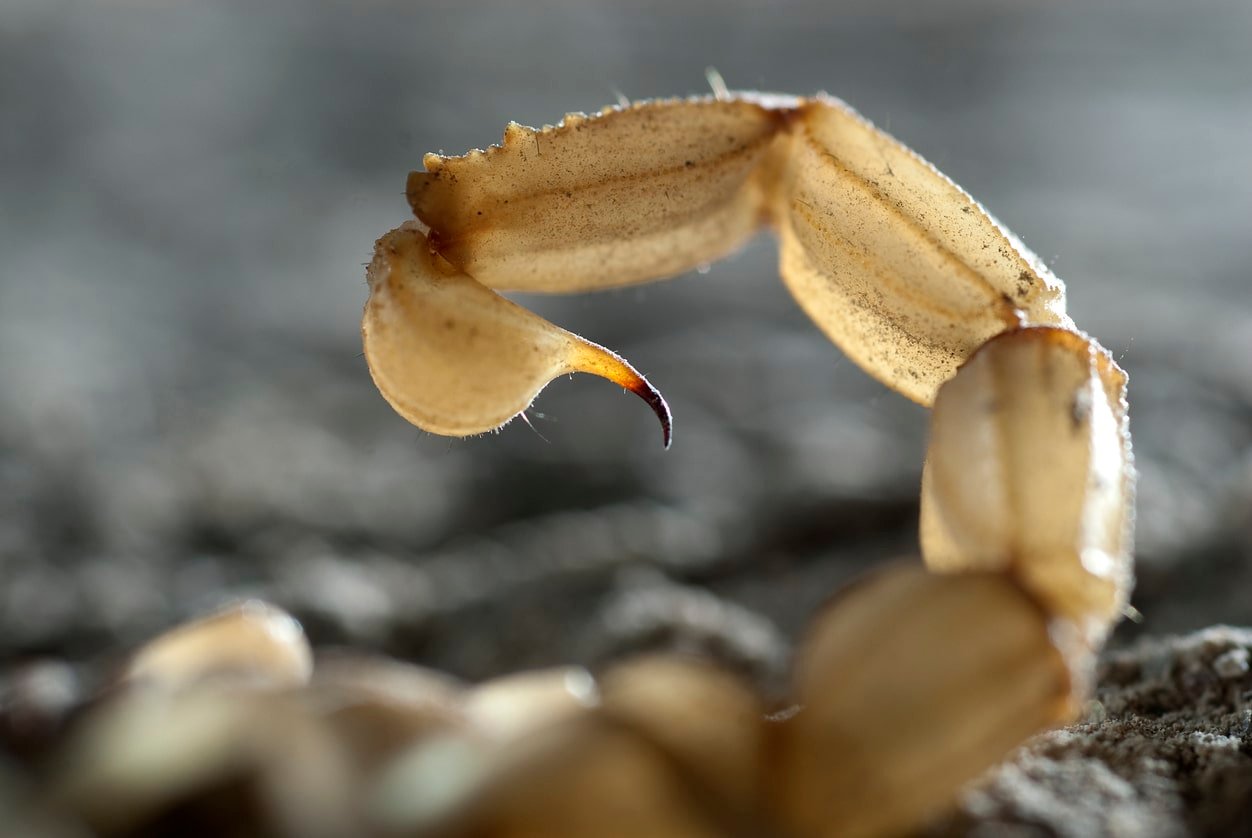Five Scorpions In Florida To Watch Out For: Photos, Where They Hide & More
Some call Florida the Australia of the United States due to the vast amount of animals and critters that live there – one of them being scorpions! You may not imagine scorpions when thinking of Florida, but there are distinct species of scorpions that live here. Some were actually brought to the state by accident, whist others are native to Florida.
So how many scorpions are there in Florida? There are five types of scorpions to look out for in Florida – the Southern Devil; Striped Bark; Florida Bark; Keys Bark; and Hentz Striped Scorpion. Whilst some of these scorpions have toxic stings, none are known for being lethal. Although on the rare occasion allergic reactions can make a sting highly dangerous.
Various qualities distinguish each of these scorpions, ranging from their size and color, to where they dwell and how dangerous their sting is. We take a deeper look at these fascinating scorpions right here, and provide information on their physical appearance, where they hide, and potential risks.

1. Southern Devil Scorpion
In contrast to many other species of scorpion, the Southern Devil Scorpion prefers to reside in a tropical area. These scorpions grow to 1.5 inches in length, have brown legs and pincers but a darker body and tail.
At the end of their tails, they have a stinger that injects venom into the insect they’re feeding on. They then utilize their strong pincers to grip onto and break apart their prey. It may sound horrifying but these scorpions are afraid of danger and would much rather flee than face a human. So if you do come across one of these Florida scorpions they’ll likely just run away!
Stinging will only occur if they are disturbed, and if they feel there is no way to get away from you. An allergic reaction to their venom can be a medical emergency, but in general the sting is similar to a bee sting. It will be unpleasant, and swelling and redness are common, as is some long-term soreness. You should visit a doctor if the discomfort worsens.

2. Striped Bark Scorpion
One of the most common scorpions in Florida is the Striped Bark Scorpion, part of the Buthidae family. They grow up to 7cm long, are a pale yellow, and are marked by two black stripes down their back. They may blend in better with their surroundings because of their coloration.
With a wide range of habitats from wild woods to deserts, they can be found around the nation as well as Florida. Crevices in rocks, plants, ancient constructions, and houses are their preferred habitats. When hunting for prey they prefer to come out during the night.
Since you can find these scorpions across the nation, it’s no surprise that thousands of individuals in the United States each year get stung by them. The stings themselves cause severe pain and inflammation. Some people have reported experiencing muscular spasms or allergic responses as a result of the venom. To handle most situations an ice pack can be used to reduce swelling. But seeking out medical attention would be our advice.

3. Florida Bark Scorpion (Slender Brown Scorpion)
The Florida Bark Scorpion is also part of the Buthidae family, which are commonly known as bark scorpions. It’s should be no shock that the Florida Bark Scorpion got its name because it lives in the state of Florida.
When it comes to length, females can grow up to 10cm, while males can grow up to 15cm! Most have black tail sections, but some are black with red, dark brown, or red with yellow legs, and others black with red or dark brown legs. Quite a variety! They like to live under rocks and trees and will move into your house if they get the chance. So may also be found under piles of trash in your yard.
Although their poison can be dangerous if allergic, it’s not as bad for you as other members of this species. Stings are itchy, painful, and can also cause swelling and sores. Some people have heart palpitations, nausea, vomiting, and diarrhea, but thankfully most don’t. If you have symptoms that aren’t redness, swelling, or itching, you may be having an allergic reaction. That requires medical attention right away.

4. Hentz Striped Scorpion
The Hentz Striped Scorpion also belongs to the Buthidae family, and so is a family member of the bark scorpion. The Hentz Scorpion species, which comes at an average size of 2 inches, is the tiniest but most abundant in Florida.
Excluding the Florida Keys, they may be found all across the state. They can range in color from light brown to dark brown, with a tan or yellow stripe on the side. Some may even have a stripe running down the middle of them.
It is common for them to live in cracks beneath stones and bark, as well as under fallen leaves. They have a sting that causes pain which lasts for about two days, with side effects such as discomfort and swelling. However some members of this scorpion family have caused lethal stings in the past, mainly due to allergic reactions.

5. Keys Bark Scorpion (Guiana Striped Scorpion)
The Keys Bark Scorpion may sting you severely if you come into contact with them. Adults of this species can reach lengths of up to four inches when they are fully grown.
Generally speaking, these scorpions are only found in the counties of Miami-Dade, Collier, and Monroe in Florida, and they are the least frequent form of scorpion that can be found there. They can be mainly found inhabiting beneath stones and bark on coastal plains and in tropical woodlands.
Initially, the sting is just somewhat irritating, but the pain can last up to five hours until it becomes unbearable. It can be spotted with two black stripes on its golden body, and may even be seen in households as they are sometimes maintained as pets in the United States. As pets, they may live for three years or more if properly cared for.

Are There Any Other Scorpions in Florida?
If you come across any scorpions in Florida they will almost certainly be one of the five listed above. However, some U.S. states have reported new scorpion species imported by accident in recent years, usually due to cargo. For example, the Guiana Striped Scorpion which can now be found in Florida was originally from the Bahamas and Cuba!
If you do come across a scorpion in Florida that doesn’t appear to be any of the five we’ve listed, then take a photo of it, note the location, and contact the U.S. Fish and Wildlife Service.
Bark Scorpions: A Bit More Information
One of the most studied scorpion families in the world is the bark scorpion. They may be found from Mexico all the way up to Florida, and are the most common type of scorpion in Florida. Variations within the species exist, with some having a distinct coloration or a larger or smaller body.
The longest known bark scorpion was found to be 8.5cm in length, including the tail. Males tend to be smaller than females. After mating, they stop growing, preventing future development.
Because they like to feed upside down, these scorpions are a one-of-a-kind species. While it may be interesting to watch, picking up a piece of outdoor furniture without realizing that a scorpion is sitting upside down below it may lead to a sting.
They have a venom that is fairly painful but has low toxicity, yet they are nonetheless dangerous. For around twenty hours after being stung you may experience excruciating discomfort and a high temperature.

How to Avoid A Scorpion Sting: Four Steps You Can Take
Scorpion stings tend to happen more inside homes than outside. So there are a few simple steps that you can take to prevent being stung.
1) Make sure you shake out any clothes and shoes before putting them on, or any towels that have been on the floor. That’s just incase a scorpion has decided to hide in them.
2) Check your sheets and bed before getting in. Make sure the bedding doesn’t reach to the floor as that could allow a scorpion to climb up onto the bed during the night, which is when they’re more active.
3) Don’t try to stomp or kill scorpions if you see them. Not only would it be a shame to kill one, they also may sting you in retaliation. If they’re inside try to relocate them using a glass and a piece of paper.
4) Don’t walk around barefoot. Be careful when outside, especially in areas with lots of foliage.
What to Do if You Get Stung
If stung, the first thing you should do is receive medical attention. This is especially important for children, the elderly, and people who have allergies.
Ideally, if you can bring the scorpion with you to the doctor by capturing it safely, this could help them determine treatment. Be careful not to get stung again.
Keep track of your symptoms so you can share this information with your doctor. Most people will experience mild symptoms such as pain, swelling, numbing, tingling, or burning. It’s possible to develop more serious symptoms ranging from muscle twitching to seizures to an irregular heartbeat. Severe symptoms are not very likely, however. But if you notice them, make sure you’re seeking medical attention as quickly as possible.
If you make the decision to treat your scorpion sting at home, wash the area with soap and water and remove any jewellery nearby in case of swelling. You can apply a cold rag to the area to help with the sting. Take a pain reliever or antihistamine to help with the symptoms after consulting with your doctor. If symptoms begin to worsen, head to the hospital immediately.
Scorpions in Florida: Our Final Thoughts
Florida is packed with amazing wildlife, including many scorpions. If you are someone who loves to explore wildlife, just make sure you’re aware and stay informed on these scorpions before going out and about. If you happen to be stung by one and seem to have an allergic reaction, seek medical attention right away.
Many people have been stung by scorpions in Florida before, and almost all have lived to tell the tale. So don’t be afraid to visit Florida as it’s a beautiful place with beautiful wildlife!








